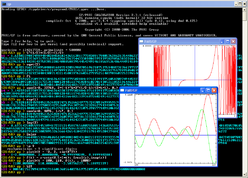PARI/GP
This articlemay rely excessively on sourcestoo closely associated with the subject,potentially preventing the article from beingverifiableandneutral.(December 2013) |
 | |
 PARI/GP in use onWindows XP | |
| Developer(s) | Henri Cohen,Karim Belabas, et al., at theUniversité Bordeaux 1 |
|---|---|
| Stable release | 2.15.5[1] |
| Repository | |
| Written in | C |
| Operating system | Cross-platform |
| Type | Computer algebra system |
| License | GNU General Public License |
| Website | pari |
PARI/GPis acomputer algebra systemwith the main aim of facilitatingnumber theorycomputations. Versions 2.1.0 and higher are distributed under theGNU General Public License.It runs on most commonoperating systems.
System overview
[edit]The PARI/GP system is a package that is capable of doing formal computations on recursive types at high speed; it is primarily aimed at number theorists. Its three main strengths are its speed, the possibility of directly usingdata typesthat are familiar tomathematicians,and its extensive algebraic number theory module.
The PARI/GP system consists of the following standard components:
- PARIis aClibrary,allowing for fast computations, and which can be called from a high-level language application (for instance, written in C,C++,Pascal,Fortran,Perl,orPython).
- gpis an easy-to-use interactivecommand line interfacegiving access to the PARI functions. It functions as a sophisticated programmable calculator which contains most of the control instructions of a standard language like C.GPis the name ofgp's scripting language which can be used to programgp.
Also available isgp2c,the GP-to-C compiler, which compiles GP scripts into the C language and transparently loads the resulting functions intogp.The advantage of this is thatgp2c-compiled scripts will typically run three to four times faster.gp2cunderstands almost all of GP.
PARI/GP performsarbitrary precisioncalculations (e.g., thesignificandcan be millions of digits long—and billions of digits on64-bitmachines). It can computefactorizations,performelliptic curvecomputations and performalgebraic number theorycalculations. It also allows computations withmatrices,polynomials,power series,algebraic numbersand implements manyspecial functions.
PARI/GP comes with its own built-in graphicalplottingcapability. PARI/GP has some symbolic manipulation capability, e.g., multivariate polynomial and rational function handling. It also has some formalintegrationanddifferentiationcapabilities.
PARI/GP can be compiled withGMP(GNU Multiple Precision Arithmetic Library) providing faster computations than PARI/GP's native arbitrary-precision kernel.
History
[edit]PARI/GP's progenitor was a program namedIsabelle,an interpreter forhigher arithmetic,written in 1979 byHenri CohenandFrançois Dressat theUniversité Bordeaux 1.[2]
PARI/GP was originally developed in 1985 by a team led by Henri Cohen at Laboratoire A2X and is now maintained byKarim Belabasat the Université Bordeaux 1 with the help of many volunteer contributors.
Etymology
[edit]The name PARI is a pun about the project's early stages when the authors started to implement a library for "Pascal ARIthmetic" in thePascal programming language(although they quickly switched toC), and after"pari de Pascal"(Pascal's Wager).[3]
The first version of thegpcalculator was originally called GPC, for Great Programmable Calculator. The trailing C was eventually dropped.[3]
Usage examples
[edit]Below are some samples of thegpcalculator usage:
?\p 212 realprecision = 221 significant digits (212 digits displayed) ? (1.378-0.09143*I)^(14.87+0.3721*I) time = 0 ms. %1 = 80.817082637557070449383034933010288336925078193546211741027496566803185 11092579265743992920628314516739962724446042667886245322716456966120413965187 3272488827365261487845201056199035423784093096984005713791800191 - 94.8384618 89186304973351271821601500916571303364865064205039706592481303045713982306764 33264430511752515705768858710051382035377195497482934017239179757538824688799 0680136241031895212412150770309289450962931402933*I ? 123456! + 0. \\ slower than gamma(123457) which uses floating point time = 1,656 ms. %2 = 2.6040699049291378729513930560926568818273270409503019584610185579952057 37967683415793560716617127908735520017061666000857261271456698589373086528293 4317244121152865814030204645985573419251305342231135573491050756 E574964 ? sin(x) time = 0 ms. %3 = x - 1/6*x^3 + 1/120*x^5 - 1/5040*x^7 + 1/362880*x^9 - 1/39916800*x^11 + 1/6227020800*x^13 - 1/1307674368000*x^15 + O(x^17) ? for(z=25,30, print (factor(2^z-1))) [31, 1; 601, 1; 1801, 1] [3, 1; 2731, 1; 8191, 1] [7, 1; 73, 1; 262657, 1] [3, 1; 5, 1; 29, 1; 43, 1; 113, 1; 127, 1] [233, 1; 1103, 1; 2089, 1] [3, 2; 7, 1; 11, 1; 31, 1; 151, 1; 331, 1] time = 5 ms. ? K = bnfinit(x^2 + 23); K.cyc time = 1ms. %4 = [3] /* This number field has class number 3. */
See also
[edit]- SageMath,a multiple-software mathematical package which includes PARI/GP as one of its components
- List of computer algebra systems
References
[edit]- ^"pari-2.15.5 (STABLE) released".
- ^François Dress (1979–1980)."Le langage et l'interpréteur 'Isabelle', spécialement conçus pour utilisations arithmétiques".Séminaire de Théorie des Nombres de Bordeaux.9.exposé № 4.
- ^ab"TRIVIA" section of"Manpage of GP,"10 August 2004
External links
[edit]- PARI/GP Development Headquarters
- PARI/GP - Mathematical software - swMATHwith a collection of references
- SIGSAM Computer Algebra Software
- Rosetta Code: PARI/GP(sample programs)
- Catalogue of GP/PARI Functions;also in downloadablegzippedtarballarchive:Stable Branch
